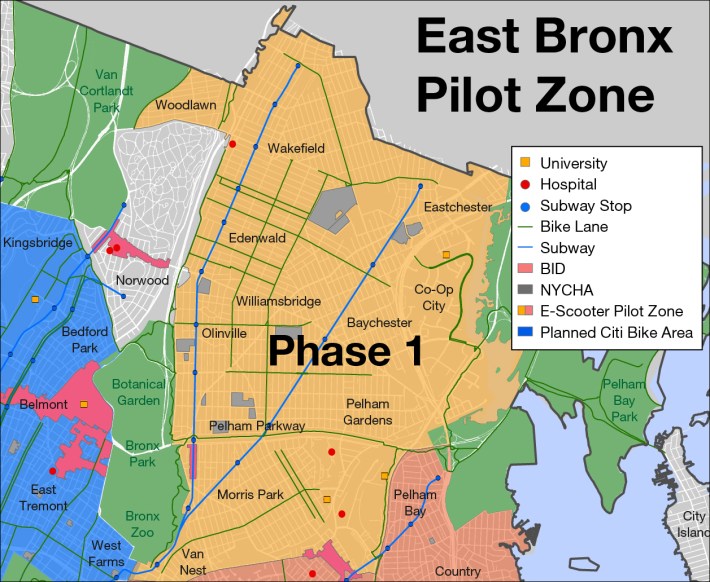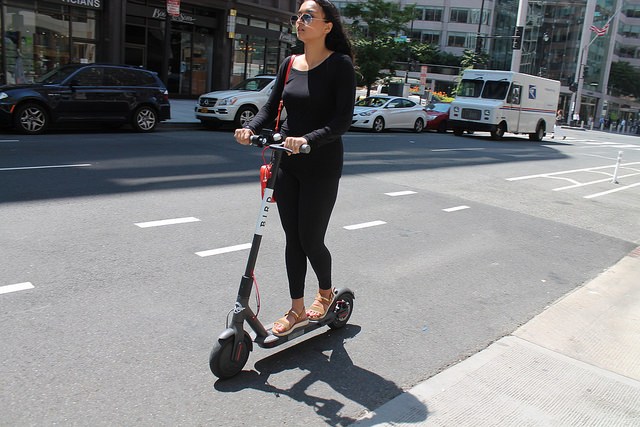
Shared e-scooters have come a long way from their arrival on the scene three years ago, and are now about to take their place on the streets of the most populous city in the country. New York City recently made e-scooters legal after years of trepidation. A proposed pilot program has shared e-scooter companies such as Spin, Lime, Lyft, Voi and Bird competing to serve The Bronx this year, and eventually all boroughs other than Manhattan.
Will e-scooters be a blessing or a curse for the city? It’s no mystery why they were long seen by some as a potential disaster for a place as densely populated as New York. Back in 2017, when Santa Monica beachgoers and commuters joyfully took to this innovative, inexpensive way to get around, it didn’t take long for things to turn sour. Riders parked in the middle of the sidewalk, blew through red lights, and ran over people’s toes. A tidal wave of backlash and annoyance followed.
This yin and yang has defined the shared mobility space for over a decade regardless of vehicle type, from Uber to dockless bikes. In the summer of 2020, the same week, a lawsuit was filed against the two largest shared e-scooter companies alleging that maintenance problems led to serious injuries, then-presidential candidate Joe Biden was making shared micro-mobility options such as e-scooters part of a clean energy plan to achieve net zero emissions by 2050.
Even with this backdrop, there’s reason to believe that e-scooters will be a boon to New York City. For one thing, the pandemic has changed the cityscape. Despite the fact that e-scooters had been illegal to use on city streets, sales skyrocketed by triple digits in the five boroughs since the pandemic began. They provide a relatively portable, emission-free, socially distanced way to get around the city. Low-cost, shared mobility options have proved to be a transportation lifeline for some essential workers who can’t afford or don’t want to own a vehicle. Shared bike programs in New York City have become an ever-more relied upon necessity as a socially distanced alternative to public transit and post-Covid-19, scooters and bikes will continue to be valuable assets in cities, extending the value of public transit lines by miles
It’s easy to get wrapped up in concerns about every new addition to the mobility landscape. Some will have seats, some not, some two wheels, some three. Some will be modular, or carry packages. In essence, no matter what iteration alternate forms of transportation show up in, their value lies in the fact that they are all opportunities to get us out of cars. Of course there will be hiccups along the way. But many e-scooter companies have grown up since their early days as disruptors, and are learning from past mistakes.
Granted, there are still valid concerns around safety. Revel, a shared moped service, temporarily closed its New York City operations last year after two fatal accidents involving its vehicles. Add to that the entire shared mobility industry is still very new, with many of the people riding these devices novices at operating them.
Steps can be taken to mitigate these problems. It is essential that shared mobility companies have sufficient operations in place such that any reports of broken or damaged scooters result in immediate removal and repair. One way of doing this is by moving away from the gig economy model, as some operators, such as Spin, have already done. Vehicle maintenance and proper facilities for carrying out that maintenance are the crux of safety.

The way we dealt with safety problems with automobiles can also provide a model for the e-scooter industry. In the 1960s, the implementation of car safety regulations saved countless lives. The e-scooter industry must focus on vehicle design and rider education to bring safety standards up to par. New technology also holds promise in this regard. AI-assisted tech that automatically slows e-scooters to a stop if the rider enters the sidewalk is now being implemented by a number of shared e-scooter companies, so that even if an operator wants to ride in a reckless manner, the technology won’t let them.
Of course, it will be impossible for any shared mobility company to avoid all rider injuries. Even when people operate e-scooters or bicycles as private vehicles, crashes happen for any number of reasons, and they do in much greater numbers in automobiles.
When great advancements in automobile safety were made, the onus wasn’t entirely on vehicle manufacturers. Improvements in roadways also greatly increased safety. These projects were funded by the government, because they were a matter of public safety. As it stands now, our transportation arteries are largely designed for and geared toward the automobile. If cities shifted urban infrastructure to prioritize slower, smaller vehicles with designated lanes, traffic barriers and vehicle-free thoroughfares (such as was done on Market Street in San Francisco and 14th Street in New York City), there is no question that riders would not only feel safer but actually be safer.
Safety aside, what annoyed people about e-scooters a few years ago isn’t that distant a memory. Integrating new forms of transportation into our cities and towns in a way that doesn’t interrupt life or provoke irritation is essential. While most riders are respectful of where they park, others have a habit of depositing their e-scooters in public areas like socks strewn around their bedroom floors. Problems with haphazard parking can be addressed by incentivizing parking at charging stations and making parking at stations mandatory. Smart vehicle add-ons that automatically reposition e-scooters to docking stations also show promise.
When municipalities provide the infrastructure necessary for human-scaled mobility, such as bike lanes, adequate sidewalks, and space designed to encourage appropriate parking of e-scooters and bikes, the disruptive aspects of the shift towards new forms of transportation are greatly mitigated. It took about 60 years for the automobile industry to achieve the safety standards required to mitigate the most harm possible. E-scooters and bikes have grown up quickly and are getting there much faster.
By putting a few key protocols in place, prioritizing vehicle maintenance and developing efficient operations, micromobility companies can ensure safety standards are up to par, and make e-scooters an integral part of the transportation landscape in New York City. With buy-in from the city, we can ensure we have a carbon-reduced, socially distanced, inexpensive and safe ride as we reorient our streets to fit the future we need to build.
Gabe Klein is the co-founder of Cityfi and the former transportation commissioner for Chicago and Washington D.C. He is also on the board of Streetsblog. Follow him on Twitter @gabe_klein






